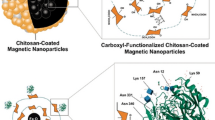Abstract
Aspergillus niger lipase immobilization by covalent binding on chitosan-coated magnetic nanoparticles (CMNP), obtained by one-step co-precipitation, was studied. Hydroxyl and amino groups of support were activated using glycidol and glutaraldehyde, respectively. Fourier transform infrared spectrometry, high-resolution transmission electron microscopy and thermogravimetric analysis confirmed reaction of these coupling agents with the enzyme and achievement of a successful immobilization. The derivatives showed activities of 309.5 ± 2.0 and 266.2 ± 2.8 U (g support)−1 for the CMNP treated with glutaraldehyde and with glycidol, respectively. Immobilization enhanced the enzyme stability against changes of pH and temperature, compared to free lipase. Furthermore, the kinetic parameters K m and V max were determined for the free and immobilized enzyme. K m value quantified for enzyme immobilized by means of glutaraldehyde was 1.7 times lowers than for free lipase. High storage stability during 50 days was observed in the immobilized derivatives. Finally, immobilized derivatives retained above 80 % of their initial activity after 15 hydrolytic cycles. The immobilized enzyme can be applied in various biotechnological processes involving magnetic separation.








Similar content being viewed by others
References
Sharmaa R, Chisti Y, Banerjeea UC (2001) Production, purification, characterization, and application of lipases. Biotech Adv 19:627–662
Sakai S, Liu Y, Yamaguchi T, Watanabe R, Kawabe M, Kawakami K (2010) Immobilization of Pseudomonas cepacia lipase onto electrospun polyacrylonitrile fibers through physical adsorption and application to transesterification in nonaqueous solvent. Biotechnol Lett 32:1059–1062
Silva JA, Macedo GP, Rodrigues DS, Giordano RLC, Gonçalves LRB (2012) Immobilization of Candida antarctica lipase B by covalent attachment on chitosan-based hydrogels using different support activation strategies. Biochem Eng J 60:16–24
Rodrigues DS, Mendes AA, Adriano WS, Gonçalves LRB, Giordano RLC (2008) Multipoint covalent immobilization of microbial lipase on chitosan and agarose activated by different methods. J Mol Catal B Enzym 51:100–109
Manrich A, Komesu A, Adriano WS, Tardioli PW, Giordano RL (2010) Immobilization and stabilization of xylanase by multipoint covalent attachment on agarose and on chitosan supports. Appl Biochem Biotech 161:455–467
Tan T, Lu J, Nie K, Deng L, Wang F (2010) Biodiesel production with immobilized lipase: A review. Biotech Adv 28:628–634
Prlainović NŽ, Knežević-Jugović ZD, Dušan MŽ, Dejan BI (2011) Immobilization of lipase from Candida rugosa on Sepabeads®: the effect of lipase oxidation by periodates. Bioproc Biosyst Eng 34:803–810
Huang J, Zhao R, Wang H, Zhao W, Ding L (2010) Immobilization of glucose oxidase on Fe3O4/SiO2 magnetic nanoparticles. Biotechnol Lett 32:817–821
Kuo C-H, Liu Y-C, Chang C-MJ, Chen J-H, Chang C, Shieh C-J (2012) Optimum conditions for lipase immobilization on chitosan-coated Fe3O4 nanoparticles. Carbohyd Polym 87(4):2538–2545
Wu Y, Wang Y, Luo G, Dai Y (2009) In situ preparation of magnetic Fe3O4-chitosan nanoparticles for lipase immobilization by cross-linking and oxidation in aqueous solution. Bioresour Technol 100:3459–3464
Xie W, Ma N (2009) Immobilized lipase on Fe3O4 nanoparticles as biocatalyst for biodiesel production. Energ Fuel 23:1347–1353
Xie W, Wang J (2012) Immobilized lipase on magnetic chitosan microspheres for transesterification of soybean oil. Biomass Bioenerg 36:373–380
Tang Z-X, Qian J-Q, Shi L-E (2007) Preparation of chitosan nanoparticles as carrier for immobilized enzyme. Appl Biochem Biotech 136:77–96
Gregorio-Jauregui KM, Pineda MG, Rivera-Salinas JE, Hurtado G, Saade H, Martínez JL, Iliná A, López RG (2012) One-step method for preparation of magnetic nanoparticles coated with chitosan. J Nanomater. doi:10.1155/2012/813958
Osuna Y, Gregorio-Jauregui KM, Gaona-Lozano JG, de la Garza-Rodríguez IM, Ilyna A, Barriga-Castro ED, Saade H, López RG (2012) Chitosan-coated magnetic nanoparticles with low chitosan content prepared in one-step. J Nanomater. doi:10.1155/2012/327562
Gregorio-Jauregui KM, Carrizalez-Alvarez SA, Rivera-Salinas JE, Saade H, Martinez JL, López RG, Segura EP, Ilyina A (2014) Extraction and immobilization of SA-α-2,6-Gal receptors on magnetic nanoparticles to study receptor stability and interaction with Sambucus nigra lectin. Appl Biochem Biotechnol 172:3721–3735
Bradford MM (1976) A rapid and sensitive method for the quantitation of microgram quantities of protein utilizing the principle of protein-dye binding. Anal Biochem 72:248–254
Hung TC, Giridhar R, Chiou SH, Wu WT (2003) Binary immobilization of Candida rugosa lipase on chitosan. J Mol Catal B - Enzym 26:69–78
Shaw JF, Chang RC, Wang FF, Wang YJ (1990) Lipolytic activities of a lipase immobilized on six selected supporting materials. Biotechnol Bioeng 35:132–137
Dove R, Madamwar D (2006) Esterification in organic solvents by lipase immobilized in polymer of PVA-alginate-boric acid. Process Biochem 41:951–955
Ranjbakhsh E, Bordbar AK, Abbasi M, Khosropour AR, Shams E (2012) Enhancement of stability and catalytic activity of immobilized lipase on silica-coated modified magnetite nanoparticles. Chem Eng J 179:272–276
Li Y, Gao F, Wei W, Qu J-B, Ma G-H, Zhou W-Q (2010) Pore size of macroporous polystyrene microspheres affects lipase immobilization. J Mol Catal B Enzym 66:182–189
Handayani N, Miletic N, Loos K, Achmad A, Wahyuningrum D (2011) Properties of immobilized Candida antarctica Lipase B on highly macroporous copolymer. Sains Malays 40:965–972
Wang S-G, Zhang W-D, Li Z, Ren Z-Q, Liu H-X (2010) Lipase immobilized on the hydrophobic polytetrafluoroethene membrane with nonwoven fabric and its application in intensifying synthesis of butyl oleate. Appl Biochem Biotech 162:2015–2026
Acknowledgments
The work is financially supported by bilateral grant SRE-CONACYT No. 187488 (Mexico) and PICT CAMEB-2012-No. 0855 (Argentina).
Author information
Authors and Affiliations
Corresponding author
Rights and permissions
About this article
Cite this article
Osuna, Y., Sandoval, J., Saade, H. et al. Immobilization of Aspergillus niger lipase on chitosan-coated magnetic nanoparticles using two covalent-binding methods. Bioprocess Biosyst Eng 38, 1437–1445 (2015). https://doi.org/10.1007/s00449-015-1385-8
Received:
Accepted:
Published:
Issue Date:
DOI: https://doi.org/10.1007/s00449-015-1385-8




